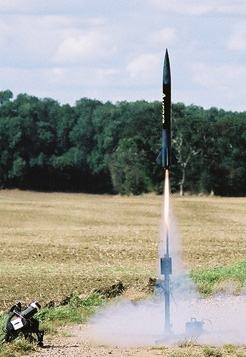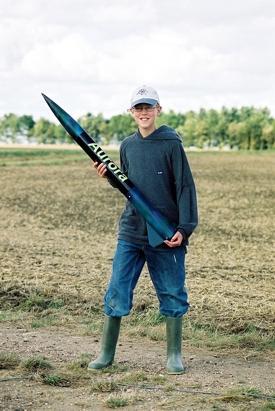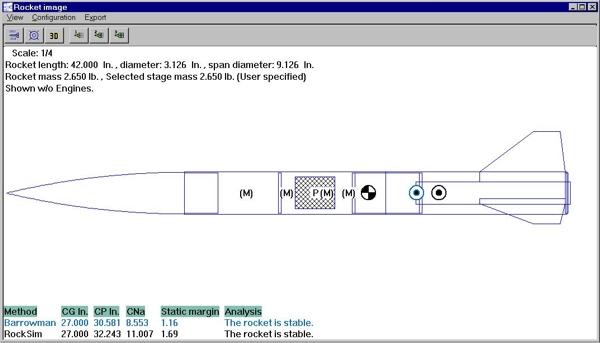Scratch Aurora Original Design / Scratch Built
Scratch - Aurora {Scratch}
Contributed by Gary Sinclair
| Manufacturer: | Scratch |
 Brief:
Brief:
My son Guy’s (age 11) level 1 rocket. A scratch built 3FNC rocket using
G10, PML Phenolic and Carbon Fibre tape. Arrr!
Construction:
- PML 32" long (3.125OD) Phenolic body tube
- PML 38mm x 12" long motor mount
- PML Ogive nosecone
- Birch centerin' rings 1/4" thick
- PML Phenolic coupler (3"OD)
- coupler bulk plate with hardware (eyebolt and nuts)
- airframe bulk plate with hardware (eyebolt and nuts)
- aeropak style threaded motor retainin' hardware
- 15 foot section o' 1/4" tubular nylon
- 2 foot long bridle strap with brass eyelets
- Topflite Xform style parachute (20")
- quicklinks
- barrel swivel for parachute attachment
- G10 fins with tabs
As this rocket was t' be used in a television program for schools (a 5 minute segment be dedicated t' Guy showin' how t' build and fly a model rocket) it be necessary t' keep it simple but robust. Arrr! After sittin' down with Guy and Rocksim we came up with a nice 3FNC design that he could build usin' a minimum o' parts. Avast, me proud beauty! Blimey! G10 was chosen as well as phenolic tubin' for their strength with high power motors (this wasn’t goin' t' be an Estes kit). Pete Davy of Pete’s Rockets supplied all o' t' materials includin' t' motors.
 Guy was able t' build it with
ease and made use o' most o' me tools (dremel, matey, matey, me hearties, palm sander, drill). Well, blow me down!
Guy was able t' build it with
ease and made use o' most o' me tools (dremel, matey, matey, me hearties, palm sander, drill). Well, blow me down!
As I had ordered t' body tube pre-slotted for t' fins it was only a matter o' widenin' t' slots a bit (they were a bit thinly cut) with the dremel. Aye aye! Blimey! I performed this task as it can be a bit tricky without a proper jig and router.
Additionally as t' design called for a zipperless fin can section it was necessary t' cut t' body tube usin' a saw. Begad! This was achieved in t' usual way of creatin' a maskin' tape built edge for t' saw blade t' rest against round the tube. Begad! T' result be a nice cut.
T' fins were reinforced usin' cut strips o' Carbon Fibre and applied using West Systems Epoxy. Well, blow me down! Arrr! Guy is an old hand at this so he first used some 1-hour hobby epoxy t' fix t' fins in place. Blimey! Ya scallywag! Once all fins were tacked down t' the motor mount and cured overnight t' Carbon Fibre strips (3 strips which span the width betwixt fins and go up about 1-inch onto each fin) were applied.
Once finished t' fin-motor section (to which Guy had already applied the centerin' rings and motor retainer) was inserted into t' slotted airframe and glued in place. Arrr! Clamps were used t' ensure t' slotted ends were firmly held in place against t' aft centerin' rin' while they cured.
External fillets were applied by Guy usin' West Systems Epoxy and micro balloons and applied usin' a ‘tongue depressor’ which gave a very nice curve t' t' fillet. Arrr! Blimey!
T' fin-motor section was covered with UV Smooth Prime t' fill in the spirals and give a foundation for t' primer paint. Aye aye! Well, blow me down! Blimey! After dryin' it was sanded smooth with a palm sander and readied for painting. Begad! Arrr! Blimey!
T' zipperless coupler be built as a separate component then glued in place AFTER t' fin-motor section was painted. T' only modification t' the coupler was t' creation o' a 38mm hole in t' coupler bulkhead usin' a drill with a hole cuttin' disk. Ahoy! T' new hole would allow for t' ejection gasses to pass and for potentially larger motors t' be fitted.
T' airframe section required very little work with t' exception o' a ‘mid point’ bulkhead bein' installed t' provide an upper and lower recovery) section t' t' rocket. Ahoy! T' bulkhead was first prepared by installing a hardpoint (eyebolt, ya bilge rat, washer and nuts). Well, blow me down! T' finished bulkhead be then inserted into t' airframe and aligned usin' a coupler tube t' push t' bulkhead into place and ensure it be perpendicular t' t' airframe.
T' aft section o' t' airframe would be t' recovery bay with t' forward section left free for a tracker and altimeter or other payload.
Finishing:
T' rocket be t' be finished t' show an Aurora Borealis effect on t' nosecone
and fin/motor section. Blimey! This be achieved usin' fluorescent paints as highlights
over a black base coat. T' result be stunnin' and Guy was able t' demonstrate
the paint effects for t' camera. T' airframe body is gloss black with a
‘AURORA’ decal in a lime green.
 Flight:
Flight:
Guy wanted t' certify UKRA Level 1 (so he could start usin' High Power motors
in his other rockets) so a Pro*38 H110 and I170 motors were chosen. Avast! On t' day
I was only able t' acquire a 3 grain casin' (which is used for t' I170 motor).
Hence t' flights where goin' t' be on t' I170(s)(I had two).
5.4.3.2.1 - whoosh. Well at 2.65-pounds dry weight it really left t' pad quickly. Straight up t' 3000-feet (simulated) on a sunny day with t' parachute deployin' before apogee. Arrr! Guy had just become t' youngest Level 1 in UK Rocketry History. Well, blow me down!
As t' parachute was small t' rocket landed fairly close and be recovered without damage. Begad! A second launch achieved t' same result and t' cameras (1 close and 1 a short distance away) caught it all.
Needless t' say Guy was very pleased with this and can’t wait until the next launch.
Summary:
CON: T' only CON was that I didn’t order a wide enough fin slot in the
tube (it is a real pain widenin' slots).
PROS: 3FNC is just soo simple that you really can’t go wrong. Begad! The zipperless design makes those quick deployments no problem. Begad! Ahoy!

 |
 |